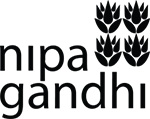Process
Block printing process:‘Nipa Gandhi’ textiles are printed by hand with carved wooden blocks in Bagru, Rajasthan, a method known as hand block printing. Our designs are carved into sisal wood by small group of tradition wood carvers who uses ancient tools with precision and intricate details. Each pattern needs separate block for colour and design. After the block is carved they are soaked in mustard oil for up to a week to ensure the wood doesn't crack when exposed to the weather conditions of the printing process. The printing tables (approx up to 8 meters) that is padded with many layers of cloth/jute/felt. A master printer dips the wooden printing block in a dye tray, then stamps the block on the fabric with a hard pound of the fist at the center of the block. Printer aligns the first block to the bottom left corner of the fabric and with incredibly precise hand eye coordination, that has been developed over years of block printing. This same process is repeated along the length and width of the fabric. After the printing process fabric is finished with final stages of washing and steaming to set the dyes.
Indigo printing and dying process:Dabu is a smooth mud paste (resist ) made from local black earth , wheat powder, gavaar (guar) tree gum, and lime. The printer gently pats the wood block onto the dabu paste tray then quickly stamps it onto the fabric. This paste acts as a resist during the dyeing process. printing with dabu, a fine layer of sawdust is sprinkled over the pattern to prevent the fabric from sticking to itself once immersed in the indigo(indigo plant indigofera tinctoriaor )/ kashish dye vat. This process is often repeated several times with indigo to achieve natural shades of light blue to a deep indigo blue. The fabric then spread out in the communal open drying field and hung from roofs and left to fix in the sun for up to three days. Once all printing and dyeing procedures are completed, the cloth is washed in the baths to remove all traces of the dabu mud, revealing the resist area to be the original white.







